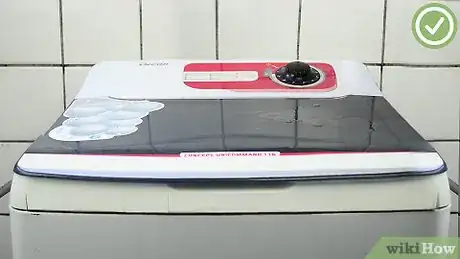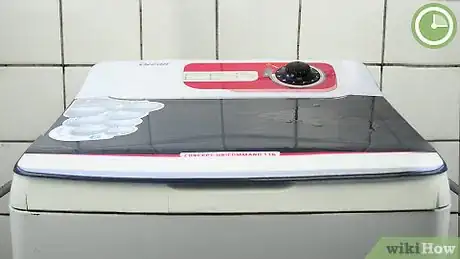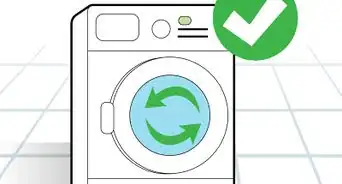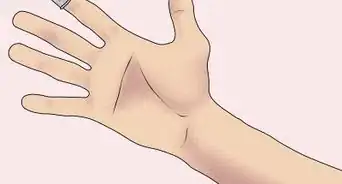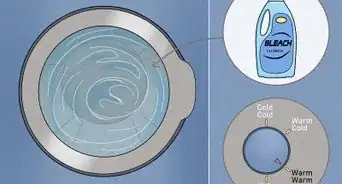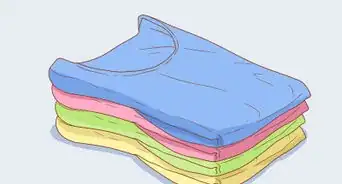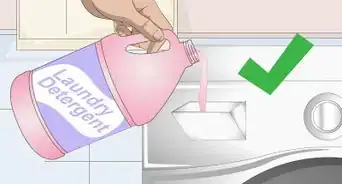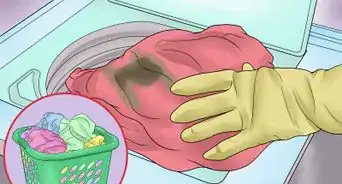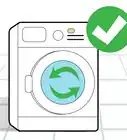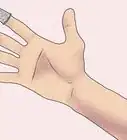This article was co-authored by Ashley Matuska and by wikiHow staff writer, Hunter Rising. Ashley Matuska is a Professional Cleaner at the Founder and Owner of Dashing Maids in Denver, Colorado. Ashley has over seven years of experience in the cleaning industry. She and her team specialize in offering sustainable deep cleaning and maintenance cleaning services.
wikiHow marks an article as reader-approved once it receives enough positive feedback. This article received 14 testimonials and 95% of readers who voted found it helpful, earning it our reader-approved status.
This article has been viewed 351,133 times.
Even though you constantly run soap through your washing machine, that doesn’t mean it cleans itself. If you wash your clothes in a machine that smells, it’s possible for the odor to transfer to the fabrics. While chemical cleaning solutions could damage your machine, you can easily make your own cleaning solution with natural ingredients like white vinegar and baking soda. This natural cleaning solution can help get rid of mildew, grime, and built up soap scum. Whether you have a top-load or front-loading machine, you can keep your machine clean and smelling great!
Steps
Scrubbing a Top-Load Machine
-
1Set your machine to the longest and hottest cycle. Turn the dials to the largest load size to completely fill your washer. Use the “heavy duty” wash cycle if you can’t manually set the amount of time your washer runs. Set the temperature knob to the hottest wash setting, press start so the drum starts to fill with water, and keep the lid open.[1]
- If your machine has a “drum clean” cycle, use that setting instead.
EXPERT TIPAshley Matuska is a Professional Cleaner at the Founder and Owner of Dashing Maids in Denver, Colorado. Ashley has over seven years of experience in the cleaning industry. She and her team specialize in offering sustainable deep cleaning and maintenance cleaning services.Professional Cleaner
 Ashley Matuska
Ashley Matuska
Professional CleanerHow often you clean your washing machine depends on how often you use it. Ashley Matuska of Dashing Maids says: "I personally do about 10 or so loads of laundry a week, so I clean my washing machine about once a month. If you use your machine less often, you can clean it every other month. To clean it, run a load on the sanitize setting, or for an older model, set it for a larger load or longer setting with hot water."
-
2Add 4 cups (950 ml) of white vinegar to the drum. Standard white vinegar you have in your kitchen will work fine. As the drum fills with water, pour the vinegar inside your machine.[2]
- Purchase a container of vinegar to strictly use for cleaning purposes so you don’t have to go to your kitchen every time you want to clean.
Advertisement -
3Pour 1 cup (220 g) of baking soda into the water. Add the baking soda while the water fills the drum so it mixes throughout the machine. The baking soda will react with the vinegar to lift any residue and clean the inside of your machine.[3]
- Keep a box of baking soda in your laundry room separate from the baking soda you use for cooking. That way, you’ll be able to make the solution when you need it.
-
4Agitate the water and let it soak for 1 hour. Close the lid on the machine for 1 minute so the cycle can start. This will mix the baking soda, vinegar, and water more thoroughly and will get your cleaning solution throughout the entire drum. After a minute, lift the lid back up to pause the cycle.[4]
- Some washing machines will lock the lid once the cycle has started. Press the stop or pause button to unlock it and open the lid.
-
5Clean the bleach, detergent, and fabric softener wells with a toothbrush or a sponge. Dip the bristles of a stiff toothbrush into the water in your machine and scrub all the wells. Focus on areas that have mold or mildew forming on them. Once you’ve scrubbed them, wipe the grime away with a clean dishcloth.[5]
- If a toothbrush isn’t working, use a stiff-bristled cleaning brush or a sponge with a scrubber side.
- Place any removable parts in the water and let them soak for 20 minutes before scrubbing them.
- Check the plastic seal around the lid. If you notice dirt and grime, scrub the area with a toothbrush.
-
6Close the machine and let the cycle complete. Shut the lid and press start on your machine if the cycle doesn’t immediately resume. Wait until the cycle is completely finished and the drum is drained of the solution.[6]
- Clean the sides and top of your machine with a damp rag while your cycle is running to make the best use of your time.
-
7Wipe the sides and bottom of the drum with a rag after the cycle finishes. Use a clean dishrag to wipe any residue off of the interior of your machine. If needed, dip one end of the rag into a mixture of 3 parts warm water and 1 part vinegar to scrub any trouble areas.[7]
- If there is a lot of residue, run another cycle with 4 c (950 ml) of vinegar to remove it.
- Keep the lid of your washing machine open in between cycles to prevent mildew and let the drum dry out.
- Clean your washer every month to keep it fresh.
Washing a Front-Load Machine
-
1Remove mildew from the seal with vinegar and a sponge. Dip a sponge into a bowl of vinegar and scrub underneath the plastic or rubber seal around the door of your washing machine. If the mildew doesn’t come up, soak it with vinegar for 20 minutes before coming back with your sponge. Wipe the seal dry with a piece of paper towel.[8]
- Use a stiff-bristled toothbrush on resilient mold or mildew.
-
2Pour 2 cups (470 ml) of white vinegar into the drum. Put the vinegar directly into the bottom of the drum. Close the door to the washing machine before moving on.[9]
- If you notice a lot of grimy buildup, add another 1⁄2 cup (120 ml) of vinegar to help loosen it up.
-
3Mix warm water and baking soda and put it in the detergent well. In a small bowl, mix 1⁄4 cup (59 ml) of water with ¼ cup (55 g) of baking soda. Once the solution is combined, pour it directly into the wells where you would put detergent, fabric softener, and bleach. This way, all the wells are cleaned when you run the machine.[10]
- If you use powder detergent, place the ¼ cup (55 g) directly into powdered detergent well.
-
4Run a normal cycle with hot water. Set the temperature of the cycle to the hottest setting your machine allows. Use the normal cycle you would for clothes or a heavy duty cycle so the cleaner has more time to soak into the drum.[11]
- The heat combined with the vinegar and baking soda will loosen and destroy any mildew or grime left inside the drum.
-
5Use a cleaning rag to wipe the drum clean when it’s finished. Use a rag dampened with clean water to wipe away any excess grime or mold inside your washing machine. If there is any mildew that stuck on during the cycle, use a scouring brush to scrape it off.[12]
- Repeat the cleaning process once per month so your washer stays clean.
Warnings
- Don’t mix vinegar with other cleaning solutions, such as bleach, ammonia, or hydrogen peroxide. Some of these mixtures can create dangerous fumes.⧼thumbs_response⧽
- Vinegar may cause irritation if you have sensitive skin. Wear rubber gloves to protect yourself.⧼thumbs_response⧽
Things You’ll Need
- Vinegar
- Baking soda
- Cleaning rags
- Toothbrush
- Rubber gloves (optional)
References
- ↑ https://youtu.be/arg9A0C-9UQ?t=33s
- ↑ https://youtu.be/arg9A0C-9UQ?t=47s
- ↑ https://www.apartmenttherapy.com/how-to-clean-a-top-loading-washing-machine-apartment-therapy-tutorials-184296
- ↑ https://www.apartmenttherapy.com/how-to-clean-a-top-loading-washing-machine-apartment-therapy-tutorials-184296
- ↑ https://www.apartmenttherapy.com/how-to-clean-a-top-loading-washing-machine-apartment-therapy-tutorials-184296
- ↑ https://www.apartmenttherapy.com/how-to-clean-a-top-loading-washing-machine-apartment-therapy-tutorials-184296
- ↑ https://www.apartmenttherapy.com/how-to-clean-a-top-loading-washing-machine-apartment-therapy-tutorials-184296
- ↑ https://www.stuff.co.nz/life-style/life/89519063/How-to-clean-your-front-loading-washing-machine
- ↑ https://www.stuff.co.nz/life-style/life/89519063/How-to-clean-your-front-loading-washing-machine
- ↑ https://www.stuff.co.nz/life-style/life/89519063/How-to-clean-your-front-loading-washing-machine
- ↑ https://www.stuff.co.nz/life-style/life/89519063/How-to-clean-your-front-loading-washing-machine
- ↑ https://www.stuff.co.nz/life-style/life/89519063/How-to-clean-your-front-loading-washing-machine
- ↑ https://www.ncbi.nlm.nih.gov/pmc/articles/PMC5748643/
- ↑ https://www.realsimple.com/home-organizing/cleaning/cleaning-more-rooms/hydrogen-peroxide-uses
About This Article
To clean your top or front-load washing machine naturally, start by pouring 2 cups of white vinegar into the drum. Then, mix ¼ cup each of water and baking soda and pour the solution into the detergent well where you usually put detergent and fabric softener. Once you’ve poured in the vinegar and baking soda solution, run your washing machine on its hottest setting to clean the drum. If your machine has a drum clean cycle, use this instead. When the cycle has finished, use a damp washcloth to wipe any leftover dirt from the drum and seal. For more tips from our Cleaning co-author, including how to clean the detergent well of your washing machine, read on!


